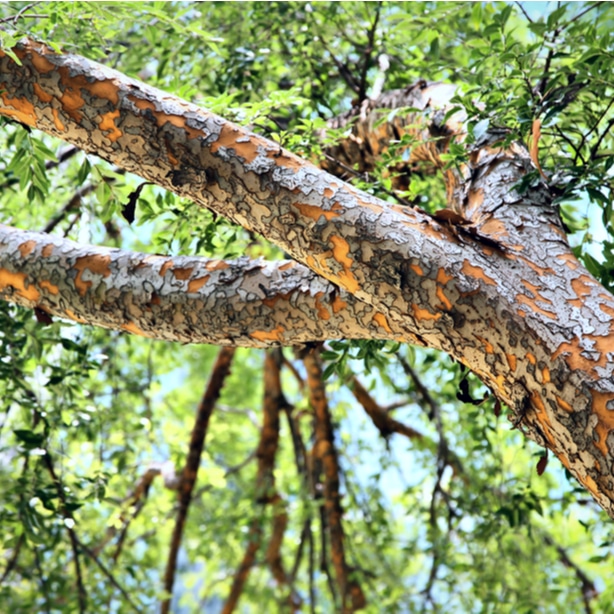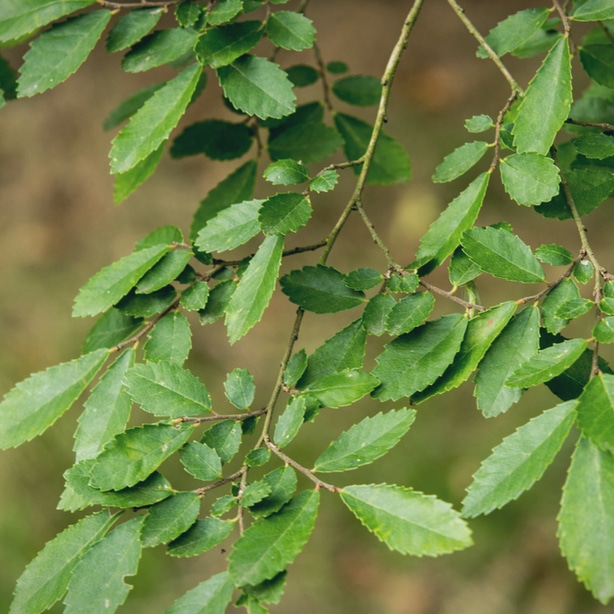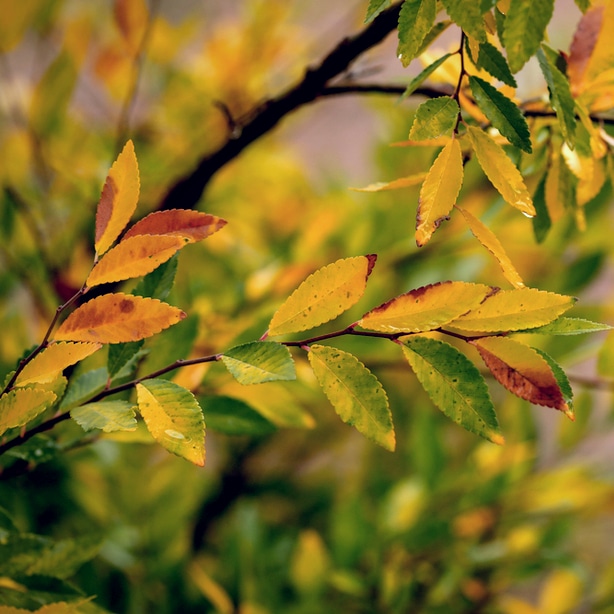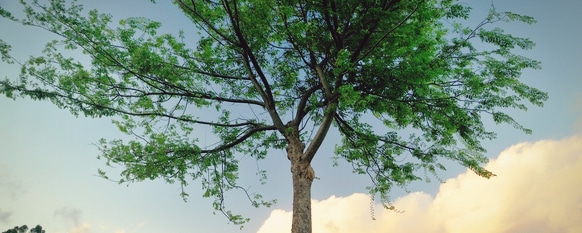It is often difficult to find trees that work well in a backyard, along the sidewalk, or as part of a larger landscape. Most gardeners are overwhelmed by their choices and often pick something that grows in abundance in their neighborhoods.
If you like this care guide, then you will also want to check our guide on how to raise and take care of hickory trees.
But there is one choice that is often overlooked. It is a beautiful large plant that is not only attractive and graceful, but also fast-growing and disease resistant.
It features dark-green foliage and weeping branches. Should the leaves not change color, then you can feast your eyes on its colorful bark.
Can you guess which eye-catching specimen we are thinking about? That’s right, it is the Chinese elm.
If you are looking for an attractive addition to your property, look no further. This is the right one for you—whether you are a hobby gardener or a seasoned landscape designer.
Keep reading to find out all you need to know about this particular species.

General Information
The Chinese elm (Ulmus parvifolia) is native to China, North Korea, Japan, and Taiwan. It is commonly known as lacebark elm.
The plant is hardy, growing in USDA zones 5 through 10. Whether it is deciduous or evergreen depends on the climate in which it grows. In a continuously warm climate, the shrub is evergreen.
The species grows very quickly. At maturity, it has reached an average height of 40 to 50 feet with a similar spread. However, some can grow up to 70 feet, if conditions are ideal.
The Chinese elm develops an upright, round, and graceful, thick canopy that is filled with long arching branches, resulting in a vase-like shape. Branches fill with glossy, attractive, 1-inch dark green leaves.
If the species is grown in the colder parts of its hardiness zone, owners can expect brilliant fall colors. In autumn, leaves turn into bright shades of purple, yellow, and red. In warmer areas, the green leaves can take on a yellow hue. One advantage is that the dropped foliage typically doesn’t create a litter problem for the surrounding landscape.
In late summer, the trees produce little greenish-red flowers. Spent flowers then develop into clusters of flat, single-seeded, winged-samara fruit that are papery-feeling. The fruit matures in fall.
Although often mistaken for a Chinese elm, a Siberian elm (Ulmus pumila) is an unrelated species. The Siberian elm has gray, deeply furrowed bark. Although it is also a quickly growing woody perennial, its branches break easily, and it is susceptible to many diseases and pests. It is considered invasive in many areas and overall inferior

Care Guide
If planted in preferred conditions and given proper care, a Chinese elm can live anywhere from 50 to 150 years.
Getting your tree off to its best start prevents potential future problems.
Preferred Amount of Sun
One of the good things about the species is that it tolerates a wide range of light conditions. It grows well in full sun to partial shade. It is unlikely to prosper when planted in full shade.
Although the plant tolerates various light conditions, full sun brings the best growth.
Preferred Soil Conditions
Another bonus of this species is that it adapts to various soil types. It tolerates both soil that is occasionally wet and soil that is dry. It also adapts to extreme changes in soil pH, tolerating everything from acidic to alkaline.
For the best growth, plant this woody perennial in an area with well-drained, rich loamy soil that is kept moist with regular watering.
Although the tree tolerates occasional wet feet, don’t plant it in an area where the soil is constantly wet and soggy. This can lead to root rot.
Watering Frequency
Once established, the species has a high tolerance for drought conditions. It’s forgiving, even if it hasn’t rained for a while and you forget to water it.
However, regular water applications produce the best growth, keeping the foliage looking its best.
Give a newly planted sapling a deep drink of water several times a week. Once the sapling establishes itself in about two to three months, you can cut back to weekly watering sessions.
You may have to water more frequently if your location has extremely hot and dry summers. If temperatures start rising above 100℉, water the plant two to three times weekly.
Spreading several inches of mulch around the trunk helps the soil retain moisture.

Fertilization
Like all plants, this species requires periodic nutrients for healthy growth.
Fertilize the tree every couple of months during the growing season of spring through summer. Use a general-purpose blend for trees, and apply as directed by the manufacturer.
When applying the fertilizer, spread it evenly under the tree’s canopy. Be sure not to bunch the fertilizer up against the trunk to prevent burning.
Once applied, water the fertilizer into the soil.
Unique Qualities
Besides its hardiness, Chinese elm trees have some unique qualities that make them an eye-catching asset of every landscape.
The tree has a resistance to several pests and diseases that have decimated native elms. It is usually resistant to Dutch elm disease, which is spread by bark beetles.
The shrub also has a resistance to phloem necrosis, a deadly disease that is spread by root grafts of leafhoppers. There’s no cure once the tree is infected, but this species can withstand it.
Chinese elms also show good resistance to Japanese beetles and the elm leaf beetle.

Landscape Design Ideas
Chinese elms have many positive attributes, which make them an excellent, but underutilized landscape tree.
Aside from their attractive dark-green leaves and graceful branches, the shrubs feature an exfoliating bark. As the bark peels away, the trunk displays molten patterns of green, orange, brown, gray, and cream. This feature is a stunning addition to any landscape design.
But the biggest bonus, besides a graceful beauty, is the ability to thrive in many conditions.
When considering a location to plant the elm permanently, always consider its mature size. You don’t want to plant it where its mature height and width interfere with structures or powerlines. Give it room to spread naturally.
Their fast growth and thick canopies make them perfect shade trees to sit and relax under to beat the summer heat.
They also are quite attractive when used as a street tree or in a sidewalk cutout. However, their roots may lift a sidewalk if planted too close.
If the size is a concern for you, consider using this species in a bonsai arrangement.
Tolerant of urban conditions, Chinese elms also work well in parking lots. They also grow well along a highway.

Companion Plants
Gardeners can choose from a wide variety of plants that complement a Chinese elm. Whether you’re looking for low-growing groundcovers or larger plants, there’s something to suit everyone’s fancy.
Plants that thrive in the same conditions and with the same basic care make good choices.
Companion Groundcovers
Plants that work well as groundcover include:
- Lily Turf (Liriope muscari)
- Hosta (Hosta spp.)
- Daffodils (Narcissus spp.)
- Virginia Bluebell (Mertensia virginica)
- Periwinkle (Vinca minor)
Companion Trees
If you’re looking for woody companions, the following work well:
- Eastern Redbud (Cercis canadensis)
- Green Giant Arborvitae (Thuja standishii x plicata ‘Green Giant’)
- Pink Flowering Dogwood (Cornus florida var. ruba)
- Chaste Tree (Vitex agnus-castus)
- Golden Rain Tree (Koelreuteria paniculata)


NEVER plant this tree in an Urban setting, or around an area with lots of buildings. The seeds spread like wildfire and propagate all over. Between garage, along building edges, etc. Not such a great tree, IMO
Drops leaves like you can’t believe. Even the leafy tips of the branches, up to five inches long. My car is covered with the leaves every day. The leaves fall into the vents at the bottom of the windshield and hood, clogging up and then falling into the engine compartment when I try to clean out the accumulated leaves. I had a gardeners hack away the overhead branches extending over my driveway. It was a neighbor’s tree. Their landlord didn’t want to pay to trim on their side do they still have tons of leaves.
Absolutely AWFUL! Planted in a courtyard of a home we bought….if you want to clean out the gutters four times every fall, net the fountain six times a day, have to use an auger to plant anything, huge root systems that wants to disrupt foundation, walkways, and anything it can find…do NOT do it!
I have this tree. It’s great shade and privacy provider, but I loathe it. The tiny leaves it drops multiple times a year get everywhere. In between my other plants. Stuck in cacti thorns. It’s not worth it. The payoff for shade and the mess I have to clean up, with lack of beauty, makes it difficult to like. It’s like a toddler of botany. Leaving a mess everywhere. I don’t find it beautiful when it has leaves and I cannot tolerate picking up another season of leaf patrol. Looking to replace it stat!
My elm just started turning yellow about 4 days ago and it’s is really yellow now what should I do
Is it Autumn? Sometimes the leaves turn in Autumn. Natural and nothing to worry about.
I have a 45 acre property and we planted our Chinese Elm in memory of our little Maltese Shitzu, Bowie. She was small like the leaves, but majestic in beauty and love. The tree has been on our property for a year and has already grown significantly. I am excited to see how large she grows.